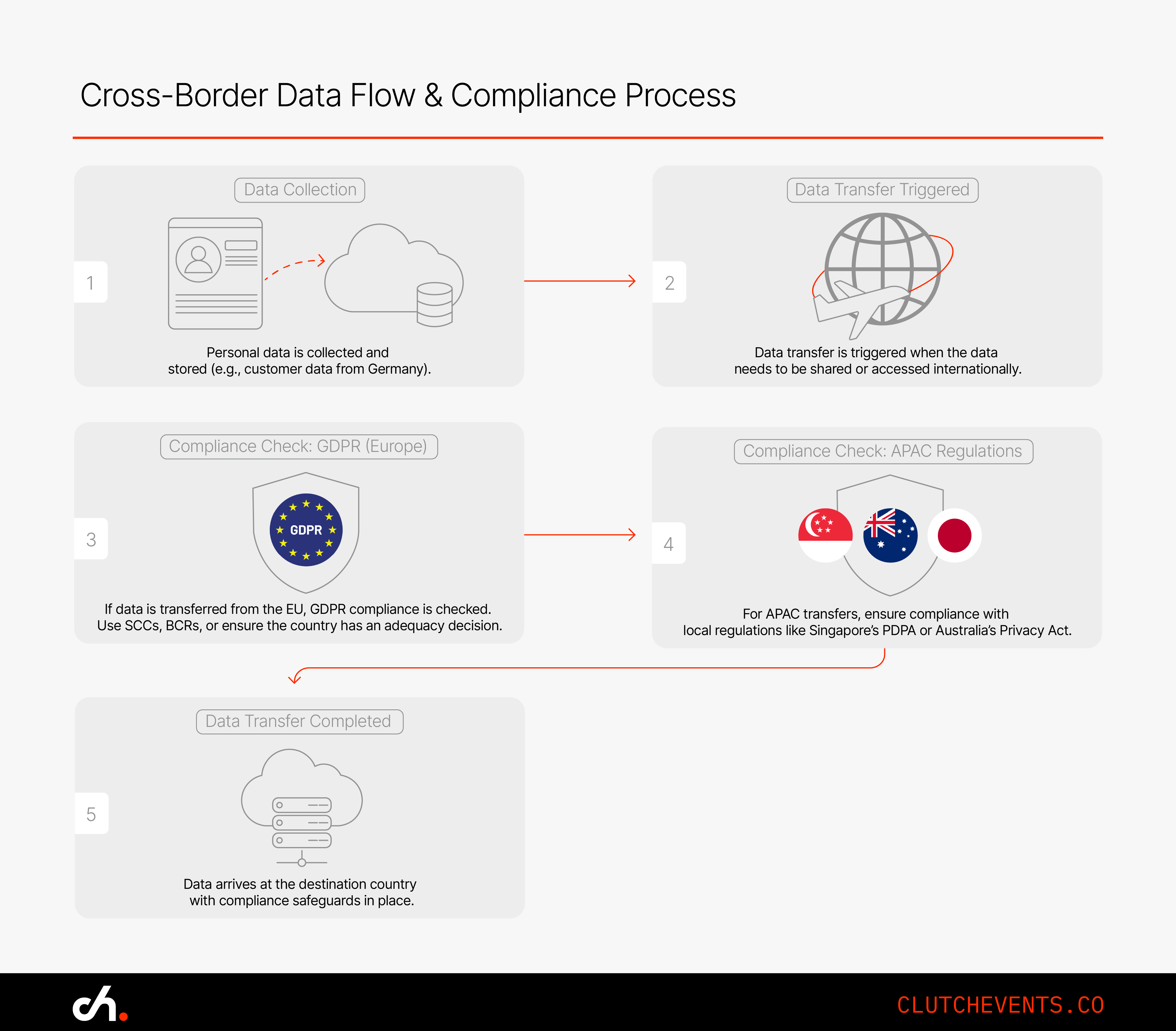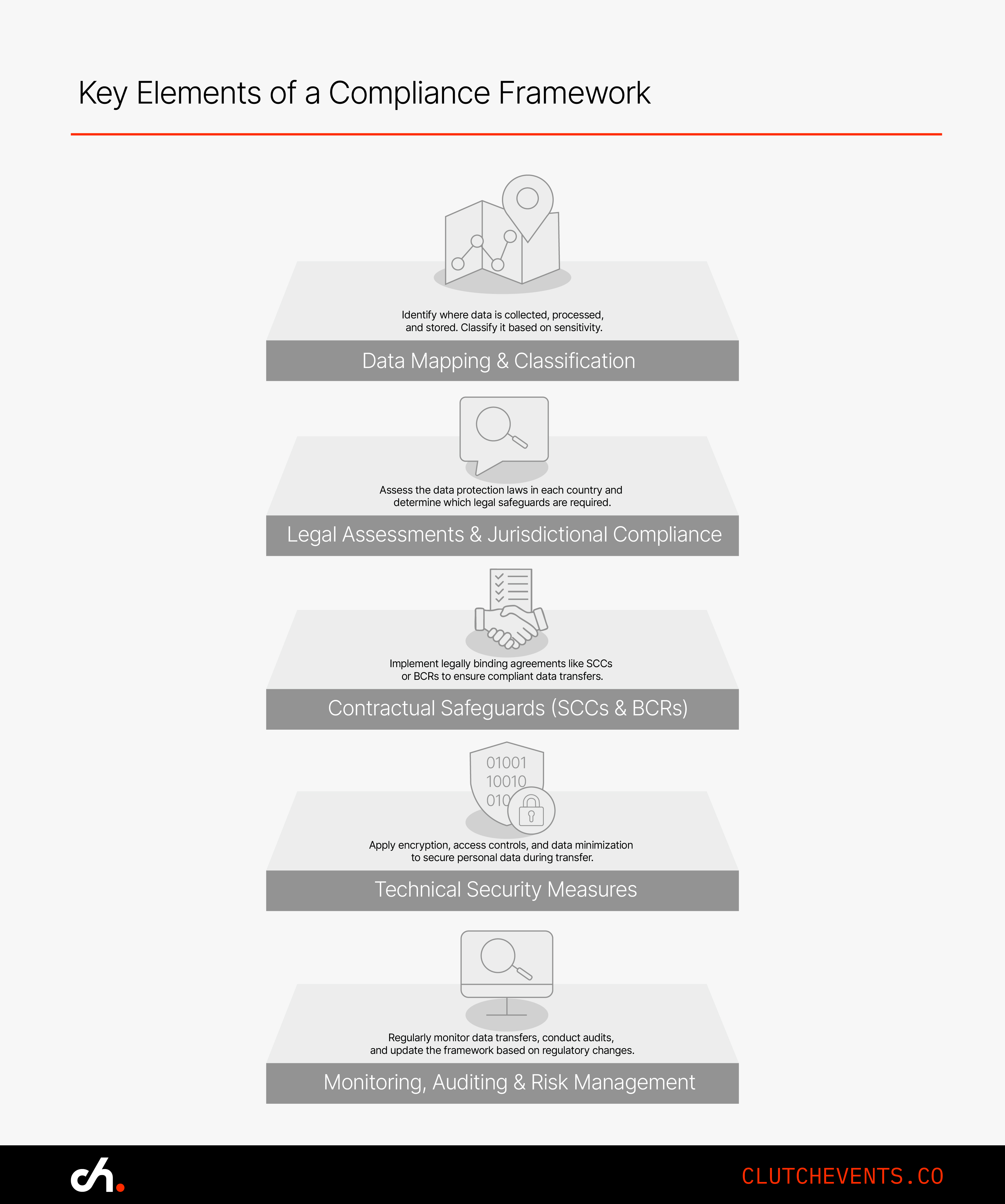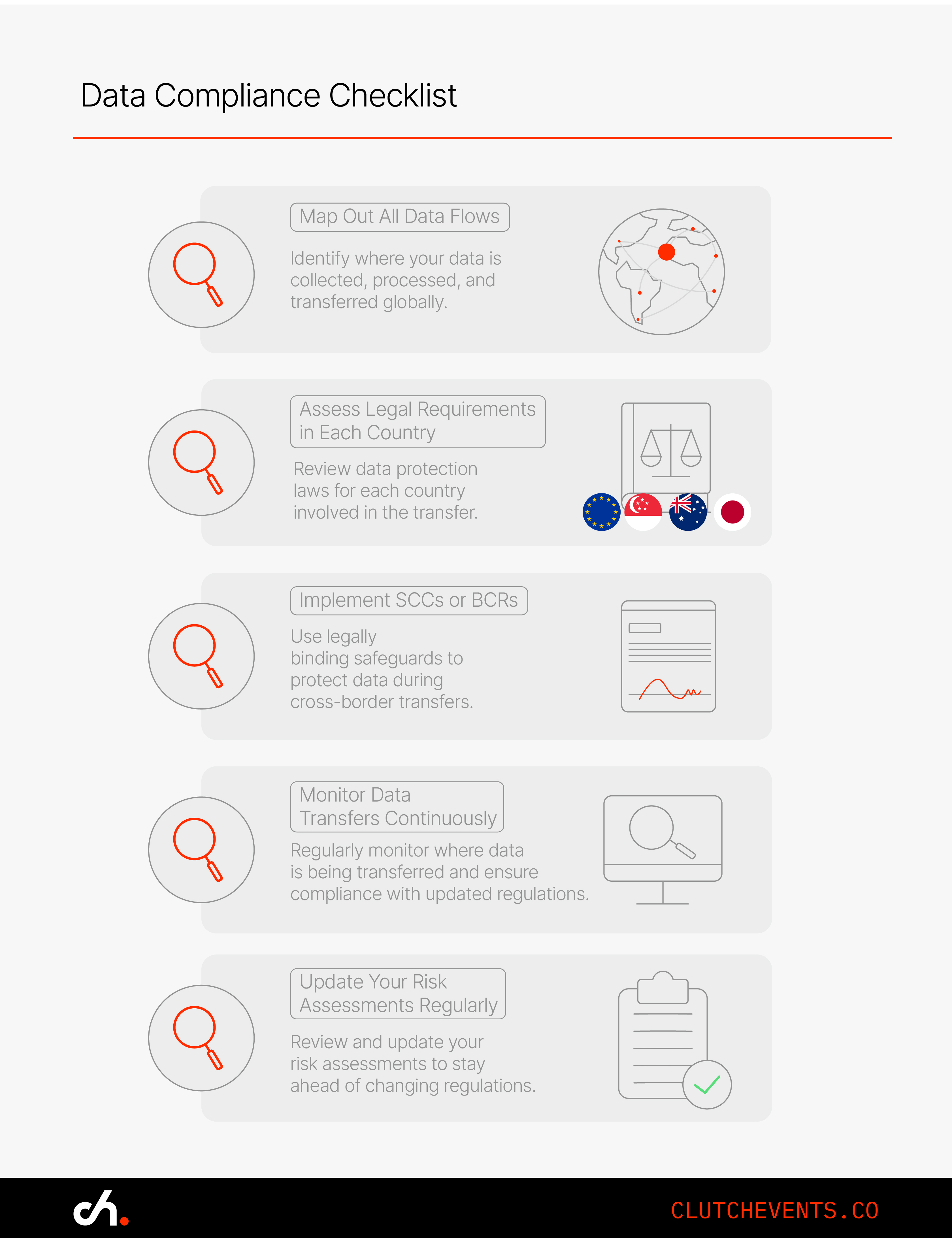Building a Compliance Framework for Cross-Border Data Transfers

Introduction
When your business operates across borders, making sure your data transfers stay compliant isn’t just good practice, it’s critical. As organisations grow and start handling data from customers, partners, and teams across different regions, the challenge of transferring personal data between countries becomes unavoidable, and the stakes are high.
Ever wonder what happens when your customer data crosses an international border? It’s not as simple as a transfer of files, it means navigating complex regulatory landscapes where data protection laws vary dramatically from one region to another. The risks are real: non-compliance can lead to heavy penalties, damage to your reputation, and loss of customer trust.
In today’s digital world, building a compliance framework for cross-border data transfers is not just about checking off legal boxes, it’s about creating a strategic process that balances business efficiency with stringent legal requirements. Here’s how your team can begin building a practical and durable framework for compliant data transfers.
Understanding Cross-Border Data Transfer Regulations
To build a strong compliance framework, you first need a clear understanding of the landscape you're operating in. Cross-border data transfers, by definition, involve moving personal data from one country to another. This can happen during routine business activities like customer support, employee management, or cloud-based services. But here’s where it gets tricky: different countries have different laws governing these transfers.
General Data Protection Regulation (GDPR)
One of the most well-known regulations affecting cross-border data transfers is the General Data Protection Regulation (GDPR), which governs data processing in the European Union (EU) and the European Economic Area (EEA). GDPR strictly limits transfers of personal data to countries outside the EEA unless specific safeguards are in place.
In practice, that means your business must meet specific conditions to remain compliant. If your business is sending personal data from Europe to the U.S., for example, you need to meet certain conditions. These could include:
- Ensuring the destination country has been deemed to provide an adequate level of data protection by the European Commission.
- Using Standard Contractual Clauses (SCCs), pre-approved legal contracts that ensure data is protected when transferred outside of the EEA.
- Implementing Binding Corporate Rules (BCRs), internal codes of conduct that multinational companies adopt to regulate data transfers within the same corporate group across borders.
Failing to meet GDPR’s cross-border requirements can be costly, with fines reaching up to €20 million or 4% of the company’s global annual turnover., with fines reaching up to €20 million or 4% of the company’s global annual turnover.
Asia-Pacific Regulations
Beyond Europe, the Asia-Pacific (APAC) region is no stranger to strict data protection laws. Countries like Singapore, Australia, and Japan have implemented regulations that govern the transfer of personal data outside their borders. Let’s explore a few key examples:
- Singapore’s Personal Data Protection Act (PDPA): Under PDPA, personal data can only be transferred overseas if the recipient country ensures a comparable level of protection or if the individual gives consent.
- Australia’s Privacy Act: Australia requires entities to ensure that any overseas recipient does not breach Australia’s privacy principles. The responsibility is on the company to ensure the overseas entity offers similar protection.
- Japan’s Act on the Protection of Personal Information (APPI): APPI allows for international data transfers if the receiving country has been deemed adequate, or if consent has been provided by the individual.
Emerging Regulations and Data Localization
With countries like India rolling out their new data protection laws and other APAC regions tightening regulations, it’s clear that the global landscape is only becoming more complex. One growing trend that companies must prepare for is data localization,the requirement to store and process data within the country of origin.
Countries like China and Russia already enforce strict data localization laws, which present significant challenges for global operations. These laws mean that businesses operating across borders must maintain data centres in multiple countries, adding cost and complexity to their operations. In the future, we might see data localization laws becoming the norm, not the exception. Companies will need to prepare for a world where data must be stored regionally while still ensuring global operations run smoothly.

Core Components of a Compliance Framework for Cross-Border Data Transfers
With the legal landscape in mind, how can your organisation ensure its cross-border data transfers remain compliant? It all starts with building a compliance framework, your blueprint for handling data in a way that meets both operational needs and regulatory requirements.
1. Data Mapping and Classification
Imagine you're a company with offices in both Singapore and Germany. Your teams are constantly sharing customer data back and forth. Now, how do you ensure that your data is safe and compliant with both GDPR and Singapore’s PDPA? This is where data mapping comes into play.
Data mapping is the process of identifying what types of personal data are collected, where it is stored, how it is processed, and to whom it is transferred. Without this map, you can’t build an effective compliance strategy. You’ll want to:
- Identify all the personal data your organisation collects, whether it’s customer, employee, or vendor data.
- Understand where the data is stored, is it in the cloud or on-premises?
- Determine where the data is being transferred, which countries are involved, and what legal frameworks apply?
Data classification follows mapping, where you categorise data based on its sensitivity. For example, you may need stricter controls for financial data or health information, as these often have higher regulatory requirements.
2. Legal Assessments and Jurisdictional Compliance
Once you’ve mapped out your data flows, it’s time to assess the legal landscape. Different countries have different rules for data transfers, so you’ll need to conduct legal assessments for each jurisdiction involved.
- GDPR Considerations: When handling data from the EU, assess whether the country receiving the data provides an adequate level of protection or if SCCs or BCRs are needed.
- APAC Considerations: For transfers to countries like Japan, Singapore, or Australia, ensure the receiving entity complies with local laws and provides comparable protections.
- Data Localization: In countries with data localization laws, assess whether certain data must be stored domestically or if any exemptions apply. This can impact the structure of your global data infrastructure.
Legal assessments ensure that you are aware of your obligations and can apply the necessary safeguards before moving data across borders.
3. Contractual Safeguards: SCCs and BCRs
So, how do you actually secure these transfers? The foundation of compliant cross-border data transfers often lies in contractual safeguards like SCCs and BCRs.
- Standard Contractual Clauses (SCCs): These are legally binding templates issued by the European Commission that ensure the data recipient provides adequate protection. SCCs are particularly useful for businesses that need to transfer data to countries without an adequacy decision.
- Binding Corporate Rules (BCRs): These are internal rules adopted by multinational companies to allow safe data transfers within the group across borders. BCRs require approval from data protection authorities and are a more permanent solution than SCCs, especially for large organisations.
4. Implementing Technical Security Measures
Cross-border data transfers involve significant risks,whether it’s data breaches, unauthorised access, or interception during transfer, whether it’s data breaches, unauthorised access, or interception during transfer. You’ll need to implement technical security measures to protect data at every step.
- Encryption: Encrypt data both in transit and at rest. This ensures that even if the data is intercepted during transfer, it remains unreadable to unauthorised parties.
- Access Controls: Limit access to personal data by implementing role-based access controls (RBAC). Only authorised personnel or systems should have access to sensitive information.
- Data Minimization: Transfer only the necessary data. Reducing the volume of data transferred limits the risk in case of a breach.
These technical measures act as layers of defence, ensuring that even if a breach occurs, the impact is minimised.
5. Monitoring, Auditing, and Risk Management
Building a framework is not a one-time task, it requires ongoing monitoring and auditing. Data protection regulations are constantly evolving, and so must your compliance strategy.
- Monitor Data Transfers: Use automated tools to track where personal data is being transferred and who is accessing it. Make sure your tools can flag any potential breaches or non-compliance issues.
- Regular Audits: Conduct internal audits of your data transfers to ensure compliance with the latest regulations. Document your findings and update your framework as needed.
- Risk Management: Create a risk management plan to identify, assess, and mitigate potential risks. This should include a response plan for breaches, ensuring your team knows exactly how to react in case of a data incident.

Challenges in Building a Cross-Border Compliance Framework
Let’s face it: building and maintaining a compliance framework isn’t easy. It comes with its fair share of challenges, especially when managing global operations.
1. Evolving Regulations
One of the biggest challenges is keeping up with evolving regulations. As countries revise or tighten their data protection laws, businesses must constantly adapt. The invalidation of the EU-US Privacy Shield in 2020 forced companies to quickly implement SCCs or other legal mechanisms to maintain compliant data transfers.
In regions like APAC, new regulations are being introduced. India, for example, has proposed its Personal Data Protection Bill, which could impose strict rules on cross-border data transfers. Organisations need to stay ahead of these changes to avoid non-compliance.
2. Managing Third-Party Vendors
If your business works with third-party vendors who process or store data in other jurisdictions, you’re still responsible for ensuring compliance. This means vendor due diligence is critical. You’ll need to verify that your vendors adhere to data protection standards, and include data protection clauses in your contracts.
Third-party management can be a logistical nightmare, but it’s essential for ensuring that your entire data ecosystem remains compliant - not just your internal operations.
3. Balancing Privacy with Business Needs
Here’s where the rubber meets the road: balancing privacy compliance with business efficiency. Many companies rely on seamless data transfers to support global operations, but regulations like GDPR and data localization laws can slow things down.
The key is to strike a balance. Implement measures that meet legal requirements but also allow your business to operate smoothly. This might involve adopting privacy-preserving technologies like differential privacy or data anonymization to enable safe and efficient transfers.
Best Practices for Implementing and Maintaining Compliance
While building a cross-border compliance framework is challenging, there are best practices you can follow to make the process smoother and more effective.
1. Conduct Regular Risk Assessments
Start with regular risk assessments. These assessments should review where data is being transferred, what security measures are in place, and how new regulations may affect compliance. By identifying potential risks early, you can take proactive steps to mitigate them.
2. Involve Legal and Security Teams
You’ll want to get your legal team involved from the start. Work closely with legal experts who specialise in global data protection laws to ensure compliance at every level. Also, collaborate with your IT and security teams to implement the technical safeguards necessary to protect your data.
3. Leverage Technology for Compliance
There are various compliance tools available that can automate parts of the process. Tools like Data Transfer Impact Assessment (DTIA) platforms can streamline your risk assessments, while monitoring solutions can automatically track compliance across multiple jurisdictions.
4. Regular Employee Training
Compliance is only as strong as the people implementing it. Train employees on cross-border data transfer rules, internal processes, and incident response protocols. Make sure they understand their responsibilities and the tools available to help them stay compliant.

Real-World Examples
1. Microsoft and Cloud Data Transfers
As a global cloud provider, Microsoft faced challenges ensuring compliant data transfers under GDPR. The company implemented BCRs to ensure that customer data could be transferred across its global data centres while maintaining compliance with EU law. Additionally, Microsoft localised data storage in regions like Germany to meet stricter data localization rules.
2. Uber and Vendor Management
Uber had to manage complex cross-border data transfers between its international offices and third-party vendors. To ensure compliance with GDPR, Uber regularly audits its third-party vendors and uses SCCs to govern data transfers to non-EEA countries. This allows the company to operate globally while adhering to data protection laws.
Conclusion
Building a compliance framework for cross-border data transfers isn’t just about meeting regulatory requirements, it’s about building trust with your customers and partners. By following best practices like data mapping, using SCCs and BCRs, implementing robust technical security measures, and staying ahead of evolving regulations, your organisation can navigate the complexities of global data transfers while maintaining compliance.
Now more than ever, cross-border data transfers are under scrutiny. But with the right framework in place, you can protect your business, meet regulatory demands, and keep your global operations running smoothly.
Compliance Checklist:
- Map out all your data flows.
- Assess the legal environment in each country.
- Implement SCCs or BCRs where necessary.
- Establish monitoring and auditing processes.
- Regularly update your risk assessment to account for evolving laws.
Related Resources
Find your Tribe
Membership is by approval only. We'll review your LinkedIn to make sure the Tribe stays community focused, relevant and genuinely useful.
To join, you’ll need to meet these criteria:
> You are not a vendor, consultant, recruiter or salesperson
> You’re a practitioner inside a business (no consultancies)
> You’re based in Australia or New Zealand



